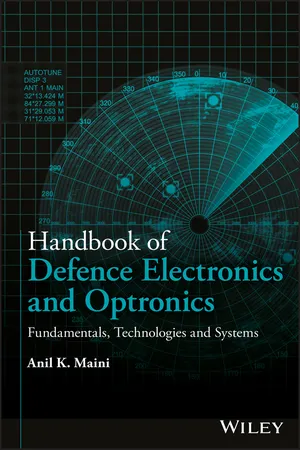
Handbook of Defence Electronics and Optronics
Fundamentals, Technologies and Systems
- English
- ePUB (mobile friendly)
- Available on iOS & Android
About this book
Handbook of Defence Electronics and Optronics
Anil K. Maini, Former Director, Laser Science and Technology Centre, India
First complete reference on defence electronics and optronics
Fundamentals, Technologies and Systems
This book provides a complete account of defence electronics and optronics. The content is broadly divided into three categories: topics specific to defence electronics; topics relevant to defence optronics; and topics that have both electronics and optronics counterparts.
The book covers each of the topics in their entirety from fundamentals to advanced concepts, military systems in use and related technologies, thereby leading the reader logically from the operational basics of military systems to involved technologies and battlefield deployment and applications.
Key features:
• Covers fundamentals, operational aspects, involved technologies and application potential of a large cross-section of military systems.
- Discusses emerging technology trends and development and deployment status of next generation military systems wherever applicable in each category of military systems.
• Amply illustrated with approximately 1000 diagrams and photographs and around 30 tables.
• Includes salient features, technologies and deployment aspects of hundreds of military systems, including: military radios; ground and surveillance radars; laser range finder and target designators; night visions devices; EW and EO jammers; laser guided munitions; and military communications equipment and satellites.
Handbook of Defence Electronics and Optronics is an essential guide for graduate students, R&D scientists, engineers engaged in manufacturing defence equipment and professionals handling the operation and maintenance of these systems in the Armed Forces.
Frequently asked questions
- Essential is ideal for learners and professionals who enjoy exploring a wide range of subjects. Access the Essential Library with 800,000+ trusted titles and best-sellers across business, personal growth, and the humanities. Includes unlimited reading time and Standard Read Aloud voice.
- Complete: Perfect for advanced learners and researchers needing full, unrestricted access. Unlock 1.4M+ books across hundreds of subjects, including academic and specialized titles. The Complete Plan also includes advanced features like Premium Read Aloud and Research Assistant.
Please note we cannot support devices running on iOS 13 and Android 7 or earlier. Learn more about using the app.
Information
1
Military Communications
1.1 Introduction to Military Communications

Table of contents
- Cover
- Title Page
- Table of Contents
- Preface
- 1 Military Communications
- 2 Radar Fundamentals
- 3 Military Radars
- 4 Satellite Technology
- 5 Military Satellites
- 6 Electronic Warfare
- 7 Laser Fundamentals
- 8 Laser Electronics
- 9 Photo Sensors and Related Devices
- 10 Military Laser Systems
- 11 Precision-Guided Munitions
- 12 Directed Energy Weapons
- Index
- End User License Agreement